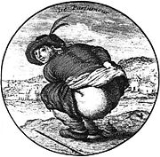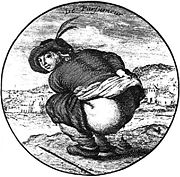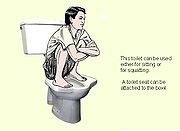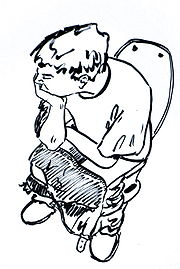
Defecation
Encyclopedia

Digestion
Digestion is the mechanical and chemical breakdown of food into smaller components that are more easily absorbed into a blood stream, for instance. Digestion is a form of catabolism: a breakdown of large food molecules to smaller ones....
by which organisms eliminate solid, semisolid or liquid waste
Waste
Waste is unwanted or useless materials. In biology, waste is any of the many unwanted substances or toxins that are expelled from living organisms, metabolic waste; such as urea, sweat or feces. Litter is waste which has been disposed of improperly...
material (feces
Feces
Feces, faeces, or fæces is a waste product from an animal's digestive tract expelled through the anus or cloaca during defecation.-Etymology:...
) from the digestive tract via the anus
Anus
The anus is an opening at the opposite end of an animal's digestive tract from the mouth. Its function is to control the expulsion of feces, unwanted semi-solid matter produced during digestion, which, depending on the type of animal, may be one or more of: matter which the animal cannot digest,...
. Waves of muscular contraction
Muscle
Muscle is a contractile tissue of animals and is derived from the mesodermal layer of embryonic germ cells. Muscle cells contain contractile filaments that move past each other and change the size of the cell. They are classified as skeletal, cardiac, or smooth muscles. Their function is to...
known as peristalsis
Peristalsis
Peristalsis is a radially symmetrical contraction and relaxation of muscles which propagates in a wave down the muscular tube, in an anterograde fashion. In humans, peristalsis is found in the contraction of smooth muscles to propel contents through the digestive tract. Earthworms use a similar...
in the walls of the colon
Colon (anatomy)
The colon is the last part of the digestive system in most vertebrates; it extracts water and salt from solid wastes before they are eliminated from the body, and is the site in which flora-aided fermentation of unabsorbed material occurs. Unlike the small intestine, the colon does not play a...
move fecal matter through the digestive tract towards the rectum
Rectum
The rectum is the final straight portion of the large intestine in some mammals, and the gut in others, terminating in the anus. The human rectum is about 12 cm long...
. Undigested food may also be expelled this way in the process called egestion.
The defecation cycle
In the adult human, the process of defecation, or the defecation cycle, is normally a combination of both voluntary and involuntary processes. The defecation cycle is the interval of time between the completion of one defecation, and the completion of the following defecation. At the start of the cycle, the rectal ampullaRectal ampulla
The rectal ampulla is the dilated section of the rectum where feces are stored until they are eliminated via the anal canal. The caliber of the rectum at its commencement is similar to that of the sigmoid colon, but near its termination it dilates, forming the ampulla....
(anatomically also: ampulla recti) acts as a temporary storage facility for the unneeded material. As additional fecal material enters the rectum, the rectal walls expand. A sufficient increase in fecal material in the rectum causes stretch receptors from the nervous system
Nervous system
The nervous system is an organ system containing a network of specialized cells called neurons that coordinate the actions of an animal and transmit signals between different parts of its body. In most animals the nervous system consists of two parts, central and peripheral. The central nervous...
located in the rectal walls to trigger the contraction of rectal muscles, relaxation of the internal anal sphincter and an initial contraction of the skeletal muscle of the external sphincter. The relaxation of the internal anal sphincter causes a signal to be sent to the brain indicating an urge to defecate.
If this urge is not acted upon, the material in the rectum is often returned to the colon
Colon (anatomy)
The colon is the last part of the digestive system in most vertebrates; it extracts water and salt from solid wastes before they are eliminated from the body, and is the site in which flora-aided fermentation of unabsorbed material occurs. Unlike the small intestine, the colon does not play a...
by reverse peristalsis where more water
Water
Water is a chemical substance with the chemical formula H2O. A water molecule contains one oxygen and two hydrogen atoms connected by covalent bonds. Water is a liquid at ambient conditions, but it often co-exists on Earth with its solid state, ice, and gaseous state . Water also exists in a...
is absorbed, thus temporarily reducing pressure and stretching within the rectum. The additional fecal material is stored in the colon until the next mass 'peristaltic' movement of the transverse and descending colon. If defecation is delayed for a prolonged period the fecal matter may harden and autolyze
Autolysis (biology)
In biology, autolysis, more commonly known as self-digestion, refers to the destruction of a cell through the action of its own enzymes. It may also refer to the digestion of an enzyme by another molecule of the same enzyme....
, resulting in constipation
Constipation
Constipation refers to bowel movements that are infrequent or hard to pass. Constipation is a common cause of painful defecation...
.
Once the voluntary signal to defecate is sent back from the brain, the final phase of the cycle begins. The rectum now contracts and shortens in peristaltic waves
Peristalsis
Peristalsis is a radially symmetrical contraction and relaxation of muscles which propagates in a wave down the muscular tube, in an anterograde fashion. In humans, peristalsis is found in the contraction of smooth muscles to propel contents through the digestive tract. Earthworms use a similar...
, thus forcing fecal material out of the rectum and out through the anal canal. The internal and external anal sphincters along with the puborectalis muscle allow the feces to be passed by pulling the anus
Anus
The anus is an opening at the opposite end of an animal's digestive tract from the mouth. Its function is to control the expulsion of feces, unwanted semi-solid matter produced during digestion, which, depending on the type of animal, may be one or more of: matter which the animal cannot digest,...
up over the exiting feces in shortening and contracting actions.
Muscular aspects
Defecation is normally assisted by taking a deep breath and trying to expel this air against a closed glottisGlottis
The glottis is defined as the combination of the vocal folds and the space in between the folds .-Function:...
(Valsalva maneuver
Valsalva maneuver
The Valsalva maneuver or Valsalva manoeuvre is performed by moderately forceful attempted exhalation against a closed airway, usually done by closing one's mouth and pinching one's nose shut...
). This contraction of expiratory chest
Chest
The chest is a part of the anatomy of humans and various other animals. It is sometimes referred to as the thorax or the bosom.-Chest anatomy - Humans and other hominids:...
muscles, diaphragm, abdominal wall muscles, and pelvic
Pelvis
In human anatomy, the pelvis is the lower part of the trunk, between the abdomen and the lower limbs .The pelvis includes several structures:...
diaphragm exert pressure on the digestive tract.
Cardiovascular aspects
During defecation, the thoracic blood pressureBlood pressure
Blood pressure is the pressure exerted by circulating blood upon the walls of blood vessels, and is one of the principal vital signs. When used without further specification, "blood pressure" usually refers to the arterial pressure of the systemic circulation. During each heartbeat, BP varies...
rises, and as a reflex response the amount of blood pumped by the heart decreases. Death has been known to occur in cases where defecation causes the blood pressure to rise enough to cause the rupture of an aneurysm
Aneurysm
An aneurysm or aneurism is a localized, blood-filled balloon-like bulge in the wall of a blood vessel. Aneurysms can commonly occur in arteries at the base of the brain and an aortic aneurysm occurs in the main artery carrying blood from the left ventricle of the heart...
or to dislodge blood
Blood
Blood is a specialized bodily fluid in animals that delivers necessary substances such as nutrients and oxygen to the cells and transports metabolic waste products away from those same cells....
clots (see thrombosis
Thrombosis
Thrombosis is the formation of a blood clot inside a blood vessel, obstructing the flow of blood through the circulatory system. When a blood vessel is injured, the body uses platelets and fibrin to form a blood clot to prevent blood loss...
). Also, in terminating the Valsalva maneuver, blood pressure falls; this, often coupled with standing up quickly to leave the toilet, results in a common incidence of fainting
Syncope (medicine)
Syncope , the medical term for fainting, is precisely defined as a transient loss of consciousness and postural tone characterized by rapid onset, short duration, and spontaneous recovery due to global cerebral hypoperfusion that most often results from hypotension.Many forms of syncope are...
.
Neurological aspects
When defecating, the external sphincter muscles relax. The anal and urethal sphincter muscles are closely linked, and experiments by Dr. Harrison Weed at the Ohio State University Medical CenterOhio State University Medical Center
The Ohio State University Medical Center is a multidisciplinary academic medical center located in Columbus, Ohio, on the main campus of The Ohio State University . In 2010, the Ohio State University Hospital was ranked one of "America's Best" by U.S. News & World Report in 11 specialties...
have shown that they can be contracted only together, not individually, and that they both show relaxation during urination. This explains why defecation is frequently accompanied by urination
Urination
Urination, also known as micturition, voiding, peeing, weeing, pissing, and more rarely, emiction, is the ejection of urine from the urinary bladder through the urethra to the outside of the body. In healthy humans the process of urination is under voluntary control...
, and why urination is frequently accompanied by flatulence
Flatulence
Flatulence is the expulsion through the rectum of a mixture of gases that are byproducts of the digestion process of mammals and other animals. The medical term for the mixture of gases is flatus, informally known as a fart, or simply gas...
.
Defecation may be involuntary or under voluntary control. Young children learn voluntary control through the process of toilet training
Toilet training
Toilet training, or potty training, is the process of training a young child to use the toilet for urination and defecation, though training may start with a smaller toilet bowl-shaped device...
. Once this has been achieved, loss of control causing fecal incontinence
Fecal incontinence
Fecal incontinence is the loss of regular control of the bowels. Involuntary excretion and leaking are common occurrences for those affected. Subjects relating to defecation are often socially unacceptable, thus those affected may be beset by feelings of shame and humiliation...
may be caused by physical injury – such as damage to the anal sphincter that may result from an episiotomy
Episiotomy
An episiotomy , also known as perineotomy, is a surgically planned incision on the perineum and the posterior vaginal wall during second stage of labor. The incision, which can be midline or at an angle from the posterior end of the vulva, is performed under local anaesthetic , and is sutured...
, intense fright, excessive pressure placed upon the abdomen, inflammatory bowel disease
Inflammatory bowel disease
In medicine, inflammatory bowel disease is a group of inflammatory conditions of the colon and small intestine. The major types of IBD are Crohn's disease and ulcerative colitis.-Classification:...
, impaired water absorption in the colon (diarrhea
Diarrhea
Diarrhea , also spelled diarrhoea, is the condition of having three or more loose or liquid bowel movements per day. It is a common cause of death in developing countries and the second most common cause of infant deaths worldwide. The loss of fluids through diarrhea can cause dehydration and...
), and psychological or neurological factors.
The loss of voluntary control of defecation is experienced frequently by those undergoing a terminal illness.
Posture aspects


Squatting position
Squatting is a posture where the weight of the body is on the feet but the knees are bent either fully or partially . In contrast, sitting, involves taking the weight of the body, at least in part, on the buttocks against the ground or a horizontal object such as a chair seat...
. Squat toilet
Squat toilet
A squat toilet is a toilet used by squatting, rather than sitting. There are several types of squat toilets, but they all consist essentially of a hole in the ground...
s, sometimes referred to as 'natural-position toilets', are still used by the vast majority of the world, including most of Africa and Asia. The widespread use of seated-position toilet
Toilet
A toilet is a sanitation fixture used primarily for the disposal of human excrement, often found in a small room referred to as a toilet/bathroom/lavatory...
s in the Western World
Western world
The Western world, also known as the West and the Occident , is a term referring to the countries of Western Europe , the countries of the Americas, as well all countries of Northern and Central Europe, Australia and New Zealand...
is a recent development, beginning in the 19th century with the advent of indoor plumbing.
Bockus in Gastroenterology, the standard textbook on the subject, states:
The ideal posture for defecation is the squatting positionSquatting positionSquatting is a posture where the weight of the body is on the feet but the knees are bent either fully or partially . In contrast, sitting, involves taking the weight of the body, at least in part, on the buttocks against the ground or a horizontal object such as a chair seat...
, with the thighs flexed upon the abdomen. In this way the capacity of the abdominal cavity is greatly diminished and intra-abdominal pressure increased, thus encouraging expulsion ...
Cleaning
The anusAnus
The anus is an opening at the opposite end of an animal's digestive tract from the mouth. Its function is to control the expulsion of feces, unwanted semi-solid matter produced during digestion, which, depending on the type of animal, may be one or more of: matter which the animal cannot digest,...
and buttocks
Buttocks
The buttocks are two rounded portions of the anatomy, located on the posterior of the pelvic region of apes and humans, and many other bipeds or quadrupeds, and comprise a layer of fat superimposed on the gluteus maximus and gluteus medius muscles. Physiologically, the buttocks enable weight to...
may be cleansed
Anal cleansing
Anal cleansing is the hygienic practice of cleaning the anus after defecation.The anus and buttocks may be cleansed with toilet paper or similar paper products, especially in many Western countries. Elsewhere, water may be used...
with toilet paper
Toilet paper
Toilet paper is a soft paper product used to maintain personal hygiene after human defecation or urination. However, it can also be used for other purposes such as blowing one's nose when one has a cold or absorbing common spills around the house, although paper towels are more used for the latter...
, similar paper products, or other absorbent material. In some cultures water is used (e.g. as with a bidet
Bidet
A bidet is a low-mounted plumbing fixture or type of sink intended for washing the genitalia, inner buttocks, and anus. It was originally a French word.-History:...
or lota) either in addition or exclusively. In Japan and South Korea, some toilets known as washlets
Toilets in Japan
There are two styles of toilets commonly found in Japan. The oldest type is a simple squat toilet, which is still somewhat common in public conveniences. After World War II, modern Western-type flush toilets and urinals became common. The current state of the art for Western-style toilets is the...
are designed to wash and dry the anus of the user after defecation.

